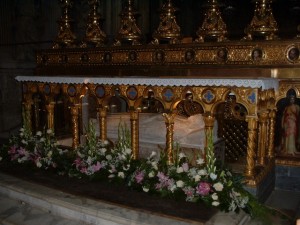I once had a private tour of part of the apostolic palace (Vatican) and when I was shown a private chapel sometimes used by the Vatican State Department. (I think the frescoes may have been done by Michelangelo, but I haven’t been able to verify it.) Anyway, one of the frescoes features a depiction of St. Catherine of Siena telling Pope Gregory XI to leave Avignon, where a succession of Popes had been for almost 70 years, and get back to Rome. My guide made wry comment about that being one of the last times a woman was able to tell a Pope what to do.
Anyway, today is her feast and if you’re in Rome, you can visit the altar where she is buried in the church of Santa Maria Sopra Minerva (Gothic church behind the Pantheon). The back of the altar is open on her feast so that the faithful can touch her tomb/casket/sarcophagus as they venerate her. Her head is in Siena, somewhat incorrupt.
Sigrid Undset wrote a very good and intense biography of Catherine. I call it intense because it really made me examine my own spiritual life. Normally, I read through books very quickly, especially if I like them. This one, however, I liked but I couldn’t plow through.
After Pope Gregory, Catherine advised Pope Urban VI who had her come from Siena to Rome so that he could rely more readily on her advice. Undset quotes Urban speaking to the cardinals:
“See, brothers, how guilty we must appear to God because we are without courage. This little woman puts us to shame. And when I call her a little woman [piccola donzella] I do not do so out of scorn, but because her sex is by nature fearful; but see how we tremble while she is strong and calm, and see how she consoles us with her words. How could the Vicar of Christ be afraid even though the whole world rise against him? Christ is stronger than the whole world, and it is impossible for Him to fail His Church.”
Sure, I’m not crazy about how he describes the female sex as “fearful by nature,” but I like how he exalts Catherine’s strength, a feminine strength of which I think the Church offers us many examples which deserve greater attention.
Here’s to yet another example of the feminine genius of which John Paul II wrote. Paul VI declared her a doctor of the Church, along with St. Teresa of Avila. St. Therese of Liseux was also made a doctor.*
(*I failed to mention Teresa of Avila in an earlier version of this post.)
Buona festa!












